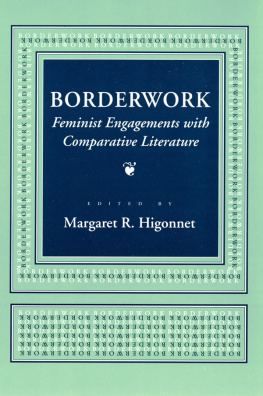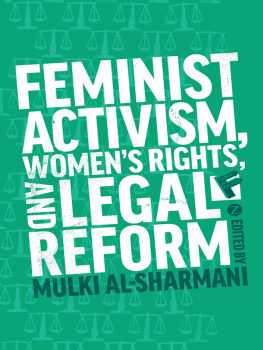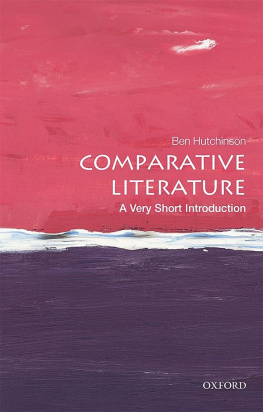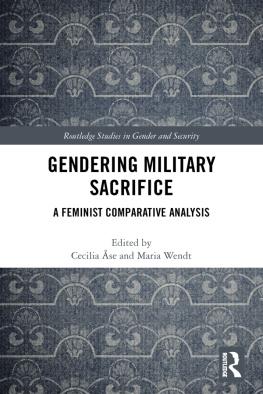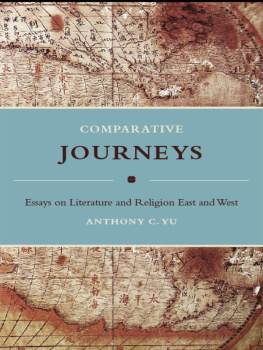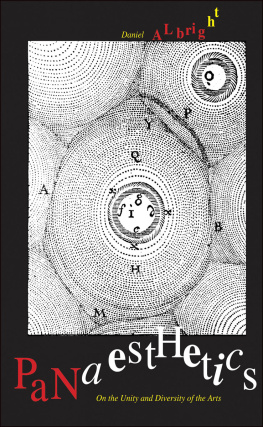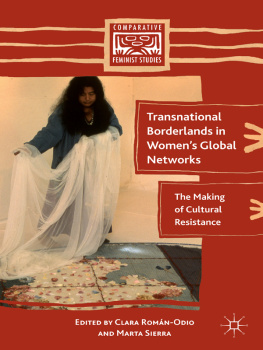Higonnet - Borderwork: feminist engagements with comparative literature
Here you can read online Higonnet - Borderwork: feminist engagements with comparative literature full text of the book (entire story) in english for free. Download pdf and epub, get meaning, cover and reviews about this ebook. City: London;Ithaca (N.Y, year: 1994;2017, publisher: Cornell University Press, genre: Romance novel. Description of the work, (preface) as well as reviews are available. Best literature library LitArk.com created for fans of good reading and offers a wide selection of genres:
Romance novel
Science fiction
Adventure
Detective
Science
History
Home and family
Prose
Art
Politics
Computer
Non-fiction
Religion
Business
Children
Humor
Choose a favorite category and find really read worthwhile books. Enjoy immersion in the world of imagination, feel the emotions of the characters or learn something new for yourself, make an fascinating discovery.
- Book:Borderwork: feminist engagements with comparative literature
- Author:
- Publisher:Cornell University Press
- Genre:
- Year:1994;2017
- City:London;Ithaca (N.Y
- Rating:5 / 5
- Favourites:Add to favourites
- Your mark:
- 100
- 1
- 2
- 3
- 4
- 5
Borderwork: feminist engagements with comparative literature: summary, description and annotation
We offer to read an annotation, description, summary or preface (depends on what the author of the book "Borderwork: feminist engagements with comparative literature" wrote himself). If you haven't found the necessary information about the book — write in the comments, we will try to find it.
Higonnet: author's other books
Who wrote Borderwork: feminist engagements with comparative literature? Find out the surname, the name of the author of the book and a list of all author's works by series.
Borderwork: feminist engagements with comparative literature — read online for free the complete book (whole text) full work
Below is the text of the book, divided by pages. System saving the place of the last page read, allows you to conveniently read the book "Borderwork: feminist engagements with comparative literature" online for free, without having to search again every time where you left off. Put a bookmark, and you can go to the page where you finished reading at any time.
Font size:
Interval:
Bookmark:

For my parents,
who forgave me
when I signed my transit papers on the wrong line
Work at the border may foster creative transformations. My small daughter crayoned for each of her toys a passport, which border controllers solemnly stamped. A bear, sock-doll, and beaver followed and displaced her own travels; they helped her to recall and renegotiate disruptions, losses, and passages. By marking the borders, she acknowledged separations, differences, connections. For me, this book has been that kind of passport: after I constructed the frame, many colleagues placed their marks in it. In the process, the essays that came to my desk led me to perceptions of comparative practice which my first frame could not accommodate. I had to let go of my preconceptions in order to let other approaches in. Once on a trip to the Van Gogh museum at Arnhem, I found myself outside the country before I realized the train was traveling in the wrong direction; then as now, however, there have been many polyglot counselors to help me reach the goal.
A collection of this kind depends on contributions from countless people: teachers, colleagues, students, friends, enemies, and frene-mies. Not only did the contributors themselves exchange papers and comments, but other readers also helped tighten the threads of argument in this web of thought. Foremost were Celeste Schenck and Margaret Ferguson, whose incisive and detailed comments dramatically transformed the manuscript. I am grateful that they found time to mother this project as they were nurturing their own children. My own work has benefited from the acuity, reflective proposals, and support of Doris Sommer, Harriet Ritvo, and Regina Barreca.
A number of comparatists have selflessly given their time and labor to help this book come into being: Mary Ann Caws, Sandie Bermann, Kathleen Komar, and Rosi Braidotti. Charles Bernheimer, Michael Palencia-Roth, and Susan Suleiman generously shared their work and ideas, as did Nancy Huston, Eleni Varikas, Carla Freccero, and Susan Winnett. Encouragement and suggestions at various points and places came from Hortense Spillers, Michelle Perrot, Earl Miner, Elaine Show-alter, Catharine Stimpson, Mieke Bal, and Jane Marcus. The book has always been in my mind and often in my suitcase; it has listened in at conferences and interjected itself into conversations. My closest friends have been tolerant of my obsession, keeping their doors open and their walking shoes on. Catherine Lugar was always ready to help me track down an elusive text.
The University of Connecticut Research Foundation, the Instituto Juan March, and the National Endowment for the Humanities supported travel and research for this project. I also thank my students at the University of Connecticut and the University of Munich, in particular Marianne Sadowski and Katharine Rodier, who have fed me a sustaining mix of photocopies, cake, printouts, and laughter.
Early and late, often very early and very late, Patrice and Ethel have been there.
M. R. H.
Margaret R. Higonnet
To survive the Borderlands
you must live sin fronteras
be a crossroads.
Gloria Anzalda
Along with Gloria Anzalda, we all dream of living without or beyond fronteras. Borderlands, to be sure, may feed growth and exploration or may conceal a mine field. The creative work of linguistic hybridity takes place at these points of encounter; here, too, systems of exclusion may lead to censorship or even death. Choices and comparisons arise at frontiers: their enigma challenges us to examine, resist, and exploit lines of division within ourselves and to test intellectual limits, whatever their source. This volume stands as such a point of engagement, where concepts basic to both comparative literature and feminist theory both intersect and pull apart.
The question of boundaries is a key to what one critic has called the permanent crisis of comparative literature. The fertility of the field has depended on asking again and again, What is to be compared with what, by whom, to what end, and under what conditions?
Precisely the indeterminacy of comparative literature as a discipline has fostered its continuous retheorizing of interpretive models and their consequences. Why that has happened may be better understood by examining the metaphor of the title, Borderwork. A border is a complex construct that defines and localizes what it strives to contain or release. It is rarely a smooth seam; an edge may ravel, gape open at interstices, or leak in both directions. Borders mark sites of rupture, connection, transmission, and transformation. Rather than understand them as static lines of demarcation, margins, or impermeable walls, therefore, we might want to examine them as what anthropologists call contact zones. Since the work of cultural transmission in contact zones is
In the late twentieth century, the violent redrawing of political frontiers around the world has complicated the comparativists ideal of open borders in a global republic of letters, an ideal that itself emerged from world conflict. The crisis provoked by renewed nationalisms and by the pursuit of ethnic purity coincides with a sustained reconsideration of definitions of geographic and linguistic identity which have regulated the discipline of comparative literature. Differences internal and external to a culture have acquired such value that some propose renaming the field contrastive literature, as an antidote to certain homogenizing, westernizing, monistic tendencies of Comparative Literature as an academic discipline.
The border has been a privileged, if hazardous, trope for feminist activity. Border feminists, to borrow a phrase coined by Sonia Sal-divar-Hull in Criticism in the Borderlands , have examined processes of marginalization that exclude texts produced by minority groups and devalue minor genres or movements. The trope can become hazardous when it conveys the claim that work on the margin brings an immunity to critique or a moral superiority; it then turns into an excuse that conceals the privileged status of most academics and the limits of individual vision.
This book works at the meeting points of comparative literature and feminist criticism, testing conceptual boundaries that constrain their practices. What might feminist engagements with comparative literature yield? A family romance or an armed conflict? The idea that feminist theories can renovate not only literary study at large but comparative literature specifically has wide currency. In an essay written for the Modern Language Association, Cary Nelson observed that feminists have shifted attention from how to interpret literature to how the discipline of literary studies is constituted. This volume explores those links, but it does not see the connection as simple or without tensions.
Whereas the anthologies that proliferated in the 1970s often suggested that comparative literature was an entity with its own unmistakable
This volume aims to break up perceptions not only of feminism as a singular theory or cultural politics, but of comparative criticism as an entity or discipline. It juxtaposes different voices, to stress not homogeneity but conflicts and discontinuities, and to do so by exploring a range of discoursesfemale circumcision, rape, slavery, and pedagogy, for example. If some of these voices propose a new relationship between comparative literature and feminist criticism, others engage a debate over the totalizing, psychologizing, and individualizing of literary and cultural difference. Theory figures here not in isolated splendor but as a practice that generates fresh readings. The clustering of essays around four topicsthe construction of identity, genre theory, the site of the critic, and institutional engagementsshould not obscure the interweaving of many of these topics within the essays.
Next pageFont size:
Interval:
Bookmark:
Similar books «Borderwork: feminist engagements with comparative literature»
Look at similar books to Borderwork: feminist engagements with comparative literature. We have selected literature similar in name and meaning in the hope of providing readers with more options to find new, interesting, not yet read works.
Discussion, reviews of the book Borderwork: feminist engagements with comparative literature and just readers' own opinions. Leave your comments, write what you think about the work, its meaning or the main characters. Specify what exactly you liked and what you didn't like, and why you think so.

